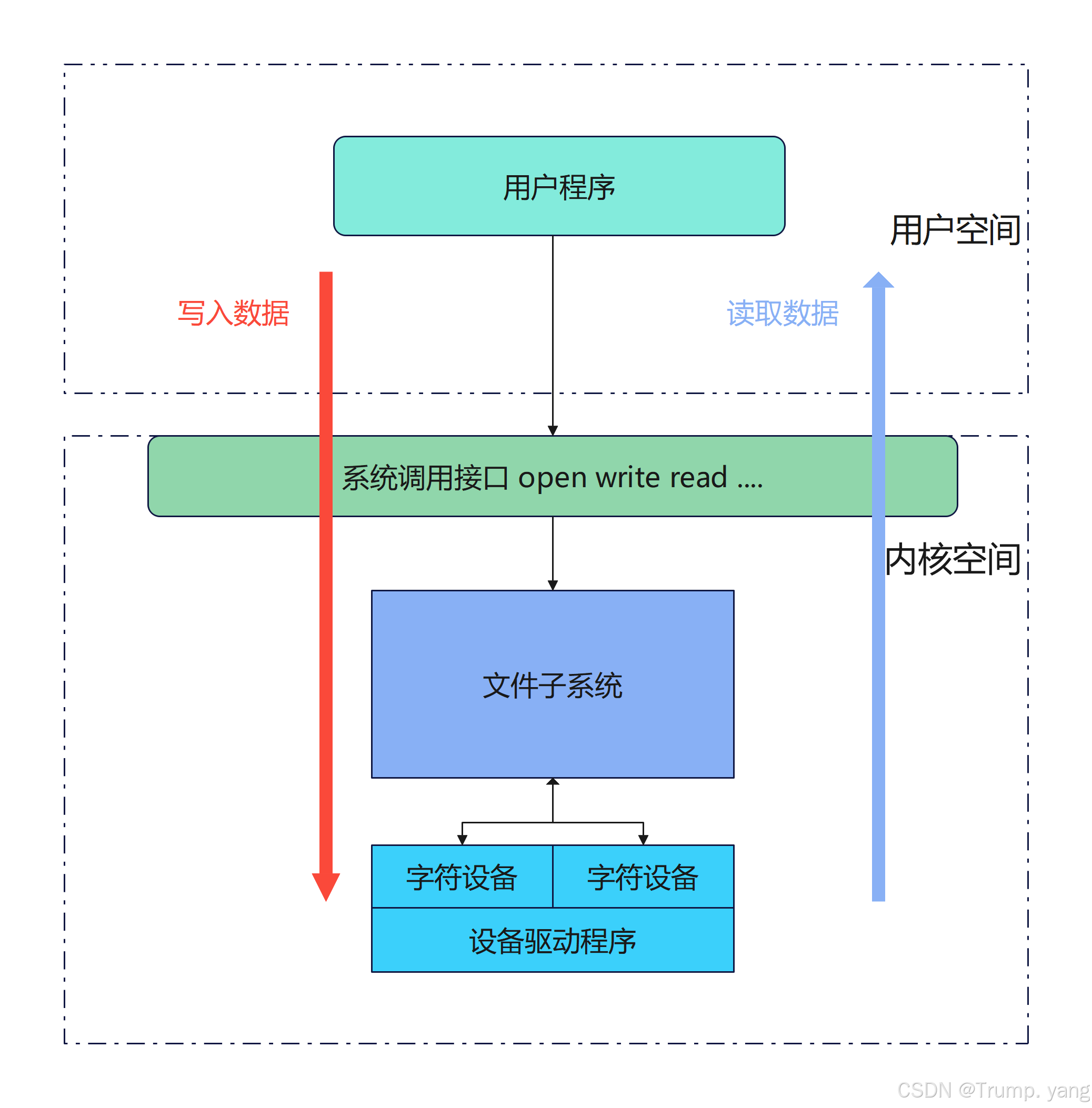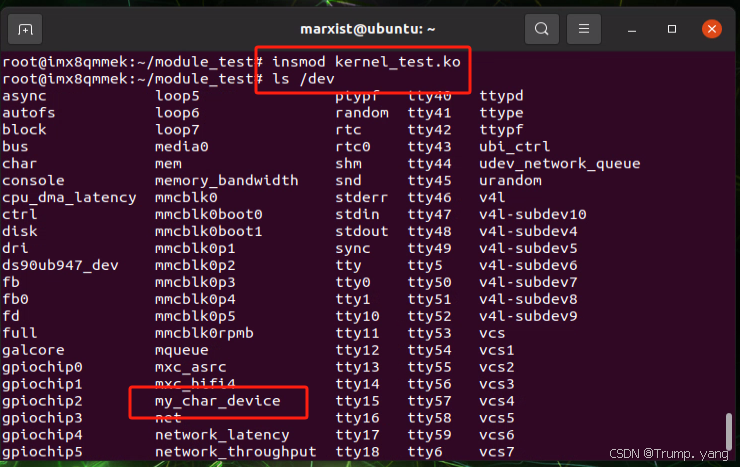往期回顾:
字符设备驱动开发基础---静态/动态注册设备号,使用cdev注册驱动-CSDN博客
字符设备驱动基础---sys文件系统,udev介绍,驱动模块在内核空间注册设备-CSDN博客
本文主要介绍的是 如何通过驱动进行设备的读写操作
文章目录
内核空间与用户空间进行数据交互
内核空间:操作系统内核运行的空间,拥有最高的权限,可以直接访问硬件资源和管理系统资源。
用户空间:用户应用程序运行的空间,权限受限,无法直接访问硬件资源,必须通过系统调用与内核交互。
交互方式:
- 系统调用(System Call):用户空间的应用程序通过系统调用请求内核执行某些操作,比如文件操作、进程管理、内存分配等。系统调用是用户空间进入内核空间的主要途径。
- 例子:
open(),read(),write(),fork()
- 例子:
系统调用
- 定义:系统调用是用户程序与操作系统内核进行交互的接口,通过系统调用,用户程序可以请求内核执行特定的服务。
- 过程:
- 用户程序发起系统调用请求。
- 处理器从用户模式切换到内核模式。
- 内核执行相应的服务程序。
- 内核模式切换回用户模式,返回结果给用户程序。
调用框架图:
注:本文只是探讨数据交互过程,没有涉及到操作寄存器,控制硬件,只是涉及到用户空间与内核空间的数据交互

驱动示例代码
#include <linux/init.h>
#include <linux/module.h>
#include <linux/fs.h>
#include <linux/cdev.h>
#include <linux/uaccess.h>
#include <linux/device.h>
#define DEVICE_NAME "my_char_device"
#define BUF_LEN 80
static char message[BUF_LEN];
static short message_len;
static int major_number;
static struct class *my_class = NULL;
static struct device *my_device = NULL;
static struct cdev mydev; // 声明 cdev 结构体
static int device_open(struct inode *inode, struct file *file) {
printk(KERN_INFO "Device opened\n");
return 0;
}
static int device_release(struct inode *inode, struct file *file) {
printk(KERN_INFO "Device closed\n");
return 0;
}
static ssize_t device_read(struct file *file, char __user *user_buffer, size_t len, loff_t *offset) {
int bytes_to_copy = message_len - *offset;
if (bytes_to_copy < 0) bytes_to_copy = 0;
if (bytes_to_copy > len) bytes_to_copy = len;
if (bytes_to_copy == 0) return 0;
if (copy_to_user(user_buffer, message + *offset, bytes_to_copy) != 0) {
return -EFAULT;
}
*offset += bytes_to_copy;
printk(KERN_INFO "Sent %d characters to the user\n", bytes_to_copy);
return bytes_to_copy;
}
static ssize_t device_write(struct file *file, const char __user *user_buffer, size_t len, loff_t *offset) {
int bytes_to_copy = len;
if (bytes_to_copy > BUF_LEN - 1) bytes_to_copy = BUF_LEN - 1;
if (copy_from_user(message, user_buffer, bytes_to_copy) != 0) {
return -EFAULT;
}
message[bytes_to_copy] = '\0';
message_len = bytes_to_copy;
printk(KERN_INFO "Received %d characters from the user\n", bytes_to_copy);
return bytes_to_copy;
}
static struct file_operations fops = {
.open = device_open,
.release = device_release,
.read = device_read,
.write = device_write,
};
static int __init test_init(void)
{
int retval;
dev_t dev;
printk(KERN_INFO "module init success\n");
// 1. 动态分配主次设备号
retval = alloc_chrdev_region(&dev, 0, 1, DEVICE_NAME);
if (retval < 0)
{
printk(KERN_ERR "Failed to allocate major number\n");
goto fail_alloc_chrdev_region;
}
major_number = MAJOR(dev);
printk(KERN_INFO "major number is: %d, minor number is: %d\n", major_number, MINOR(dev));
// 2. 初始化 cdev 结构体并添加到内核
cdev_init(&mydev, &fops);
retval = cdev_add(&mydev, dev, 1);
if (retval < 0)
{
printk(KERN_ERR "Failed to add cdev\n");
goto fail_cdev_add;
}
// 3. 创建设备类
my_class = class_create(THIS_MODULE, "my_class");
if (IS_ERR(my_class))
{
printk(KERN_ERR "Failed to create class\n");
retval = PTR_ERR(my_class);
goto fail_class_create;
}
// 4. 申请设备,内核空间就会通知用户空间的udev 进行创建设备,驱动程序本身自己是创建不了文件的!
my_device = device_create(my_class, NULL, dev, NULL, DEVICE_NAME);
if (IS_ERR(my_device))
{
printk(KERN_ERR "Failed to create device\n");
retval = PTR_ERR(my_device);
goto fail_device_create;
}
printk(KERN_INFO "my_char_device: module loaded\n");
return 0;
fail_device_create:
class_destroy(my_class);
fail_class_create:
cdev_del(&mydev);
fail_cdev_add:
unregister_chrdev_region(dev, 1);
fail_alloc_chrdev_region:
return retval;
}
static void __exit test_exit(void)
{
dev_t dev = MKDEV(major_number, 0);
if (my_device)
device_destroy(my_class, dev);
if (my_class)
class_destroy(my_class);
cdev_del(&mydev);
unregister_chrdev_region(dev, 1);
printk(KERN_INFO "my_char_device: module unloaded\n");
}
module_init(test_init);
module_exit(test_exit);
MODULE_AUTHOR("Marxist");
MODULE_LICENSE("GPL");关键解析
Linux理念:一切皆为文件,因此设备也是一种文件,也可以直接进行读写操作。
device_open 和 device_release:设备打开和关闭时的处理函数。
device_read:从设备读取数据并复制到用户空间。
device_write:从用户空间写入数据到设备。
文件操作函数实现
static int device_open(struct inode *inode, struct file *file) {
printk(KERN_INFO "Device opened\n");
return 0;
}
static int device_release(struct inode *inode, struct file *file) {
printk(KERN_INFO "Device closed\n");
return 0;
}
static ssize_t device_read(struct file *file, char __user *user_buffer, size_t len, loff_t *offset) {
int bytes_to_copy = message_len - *offset;
if (bytes_to_copy < 0) bytes_to_copy = 0;
if (bytes_to_copy > len) bytes_to_copy = len;
if (bytes_to_copy == 0) return 0;
if (copy_to_user(user_buffer, message + *offset, bytes_to_copy) != 0) {
return -EFAULT;
}
*offset += bytes_to_copy;
printk(KERN_INFO "Sent %d characters to the user\n", bytes_to_copy);
return bytes_to_copy;
}
static ssize_t device_write(struct file *file, const char __user *user_buffer, size_t len, loff_t *offset) {
int bytes_to_copy = len;
if (bytes_to_copy > BUF_LEN - 1) bytes_to_copy = BUF_LEN - 1;
if (copy_from_user(message, user_buffer, bytes_to_copy) != 0) {
return -EFAULT;
}
message[bytes_to_copy] = '\0';
message_len = bytes_to_copy;
printk(KERN_INFO "Received %d characters from the user\n", bytes_to_copy);
return bytes_to_copy;
}文件操作结构体
定义文件操作结构体,将文件操作函数指针绑定到对应的操作函数。
static struct file_operations fops = {
.open = device_open,
.release = device_release,
.read = device_read,
.write = device_write,
};本文重点使用的函数:copy_to_user 和 copy_from_user
copy_to_user 用于将数据从内核空间复制到用户空间。函数原型如下:
int copy_to_user(void __user *to, const void *from, unsigned long n);to:目标用户空间地址。from:源内核空间地址。n:要复制的字节数。
如果复制成功,返回 0;如果失败,返回未能复制的字节数。
copy_from_user 用于将数据从用户空间复制到内核空间。函数原型如下:
int copy_from_user(void *to, const void __user *from, unsigned long n);to:目标内核空间地址。from:源用户空间地址。n:要复制的字节数。
如果复制成功,返回 0;如果失败,返回未能复制的字节数。
用户程序示例代码
#include <stdio.h>
#include <stdlib.h>
#include <string.h>
#include <unistd.h>
#include <fcntl.h>
#include <errno.h>
int main(int argc, char *argv[]) {
int fd;
char buf[80] = {0};
// 检查参数数量
if (argc < 2) {
fprintf(stderr, "Usage: %s <r|w> [data_to_write]\n", argv[0]);
return -1;
}
// 打开设备节点
fd = open("/dev/my_char_device", O_RDWR);
if (fd < 0) {
perror("open error");
return -1;
}
if (strcmp(argv[1], "w") == 0) {
// 写操作
if (argc < 3) {
fprintf(stderr, "Please provide data to write.\n");
close(fd);
return -1;
}
strncpy(buf, argv[2], sizeof(buf) - 1);
if (write(fd, buf, sizeof(buf)) < 0) {
perror("write error");
close(fd);
return -1;
}
printf("Data written: %s\n", buf);
} else if (strcmp(argv[1], "r") == 0) {
// 读操作
if (read(fd, buf, sizeof(buf)) < 0) {
perror("read error");
close(fd);
return -1;
}
printf("Data read: %s\n", buf);
} else {
fprintf(stderr, "Invalid operation. Use 'r' for read or 'w' for write.\n");
close(fd);
return -1;
}
// 关闭设备节点
close(fd);
return 0;
}实现了简单对设备的读写测试, 主要是调用了 系统调用 的 open read write 接口
实现效果
加载编译后的模块到内核,在dev目录生成了 my_char_device 设备文件

运行编译好的用户程序

同样的也可以直接使用cat 和echo命令
